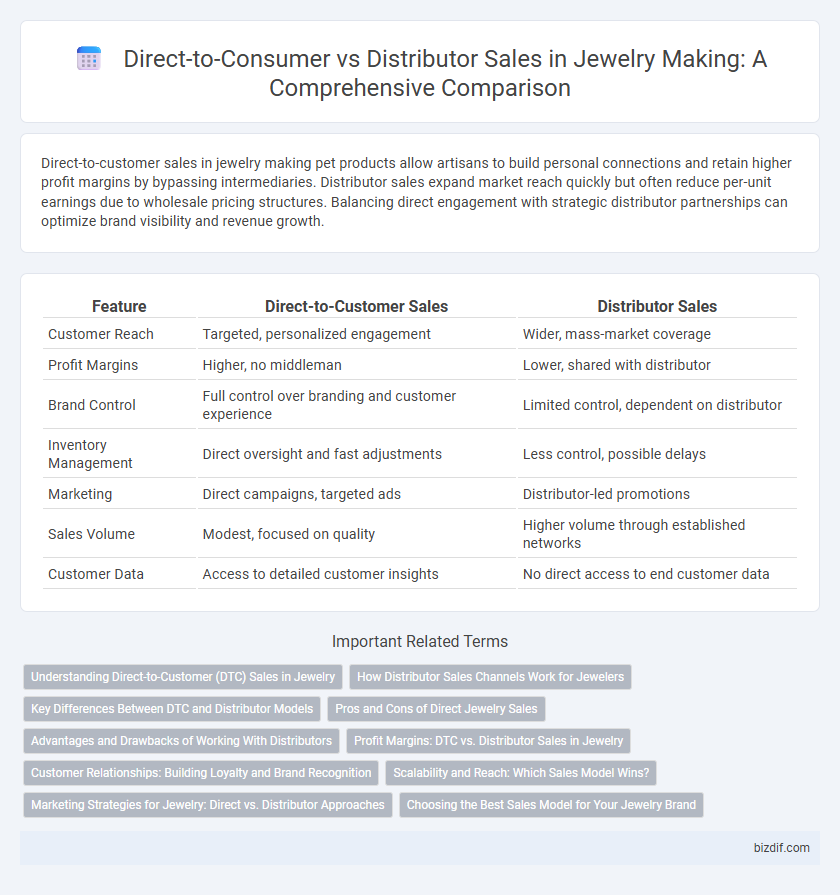Direct-to-customer sales in jewelry making pet products allow artisans to build personal connections and retain higher profit margins by bypassing intermediaries. Distributor sales expand market reach quickly but often reduce per-unit earnings due to wholesale pricing structures. Balancing direct engagement with strategic distributor partnerships can optimize brand visibility and revenue growth.
Table of Comparison
| Feature | Direct-to-Customer Sales | Distributor Sales |
|---|---|---|
| Customer Reach | Targeted, personalized engagement | Wider, mass-market coverage |
| Profit Margins | Higher, no middleman | Lower, shared with distributor |
| Brand Control | Full control over branding and customer experience | Limited control, dependent on distributor |
| Inventory Management | Direct oversight and fast adjustments | Less control, possible delays |
| Marketing | Direct campaigns, targeted ads | Distributor-led promotions |
| Sales Volume | Modest, focused on quality | Higher volume through established networks |
| Customer Data | Access to detailed customer insights | No direct access to end customer data |
Understanding Direct-to-Customer (DTC) Sales in Jewelry
Direct-to-customer (DTC) sales in jewelry enable brands to retain full control over pricing, customer experience, and brand storytelling while bypassing traditional distributors and retailers. This approach leverages e-commerce platforms, social media marketing, and personalized customer interactions to build strong brand loyalty and gather valuable consumer insights. By selling directly, jewelry makers can increase profit margins, rapidly adapt to market trends, and offer exclusive collections tailored to their target audience.
How Distributor Sales Channels Work for Jewelers
Distributor sales channels for jewelers involve intermediaries who purchase jewelry pieces in bulk from manufacturers and sell them to retailers, expanding market reach without the jeweler managing individual customer relationships. These channels enable jewelers to benefit from established distribution networks, reducing the financial and logistical burden of direct sales while accessing diverse market segments. Effective distributor partnerships require clear agreements on pricing, branding, and inventory management to maintain product quality and brand reputation throughout the supply chain.
Key Differences Between DTC and Distributor Models
Direct-to-customer (DTC) sales in jewelry making enable brands to control their pricing, branding, and customer experience while capturing higher profit margins by eliminating intermediaries. Distributor sales rely on third-party partners to reach a broader market but often result in reduced profit margins and less control over brand presentation and customer relationships. The choice between DTC and distributor models significantly impacts supply chain management, marketing strategies, and revenue streams within the jewelry industry.
Pros and Cons of Direct Jewelry Sales
Direct jewelry sales allow artisans to establish personal connections with customers, enhancing brand loyalty and enabling better control over pricing and profit margins. However, direct sales require significant investment in marketing, customer service, and logistics, which can limit scalability and increase operational complexity. Relying solely on direct sales may reduce market reach compared to distributor channels, potentially slowing brand exposure in international or diverse markets.
Advantages and Drawbacks of Working With Distributors
Working with distributors in jewelry making expands market reach by leveraging established retail networks and reducing the burden of logistics and customer service. However, distributors often demand lower wholesale prices, which can diminish profit margins and limit brand control, impacting how the jewelry is marketed and presented. Dependence on distributors may also delay feedback from end customers, making it harder to quickly adapt to market trends or preferences.
Profit Margins: DTC vs. Distributor Sales in Jewelry
Direct-to-customer (DTC) sales in jewelry typically yield higher profit margins by eliminating intermediaries and allowing brands to set retail prices. Distributor sales often reduce margins due to wholesale pricing and shared profits with retailers, but they can increase market reach and volume. Balancing DTC profits with distributor partnerships depends on brand strategy and growth goals in the competitive jewelry market.
Customer Relationships: Building Loyalty and Brand Recognition
Direct-to-customer sales foster stronger customer relationships through personalized service and direct feedback, enhancing brand recognition and loyalty. In contrast, distributor sales often dilute this connection, making it harder to engage customers personally and build long-term loyalty. Jewelry makers leveraging DTC strategies benefit from direct control over the customer experience, leading to higher repeat purchase rates and stronger brand advocacy.
Scalability and Reach: Which Sales Model Wins?
Direct-to-customer sales offer jewelry makers greater control over branding and customer experience, enabling scalable growth through online platforms and personalized marketing strategies. Distributor sales provide broader initial reach by leveraging established networks and retail relationships, yet often limit scalability due to reduced margins and less direct customer engagement. Scalability favors direct-to-customer models as they allow for flexible expansion and data-driven decision-making, whereas distributor sales excel in rapid market penetration but may hinder long-term growth.
Marketing Strategies for Jewelry: Direct vs. Distributor Approaches
Direct-to-customer sales in jewelry marketing allow brands to build personalized relationships and gather valuable consumer data for targeted campaigns, enhancing customer loyalty and increasing profit margins. Distributor sales expand market reach by leveraging established networks and retail presence, yet often reduce brand control and dilute marketing messages. Effective strategies balance direct online platforms with selective distributor partnerships to optimize brand visibility and revenue growth.
Choosing the Best Sales Model for Your Jewelry Brand
Direct-to-customer sales offer jewelry brands higher profit margins and direct control over branding and customer experience, essential for building strong relationships and personalized marketing. Distributor sales expand market reach quickly through established retail networks but often reduce overall profit margins and control over pricing and brand presentation. Evaluating your brand's growth stage, resources, and target audience helps determine whether a direct sales model or distributor partnership best maximizes revenue and brand equity in the competitive jewelry market.
Direct-to-customer sales vs distributor sales Infographic

 bizdif.com
bizdif.com